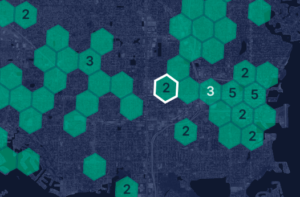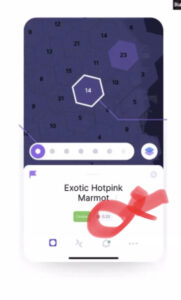There are a few key concepts to understand to maximize earnings: The roles of Hexagons, Transmit Scale, Height, and Antennas.
Hexagons
Hexagons are the six-sided shapes that Helium overlays and divides the surface of the earth. The algorithm rewards owners for placing hotspots in adjacent Hexagons. The more adjacent hexagons with a hotspot (you can have a total of six) the more the hotspot will earn. This is how Helium gets its owners to “spread out” in an optimal fashion. You can find a map of the hexagons where your hotspot is located on the app or by searching for the name of your hotspot on Helium Explorer (below).
.
All the green hexagons have at least one hotspot. Below is a similar view on the phone app:

Transmit scale
Helium’s algorithm penalizes owners for locating hotspots in the same Hexagon.
The transmit scale (the number circled in red) shows how the HNT’s mined between the owners. One hotspot in a hexagon will have a scale of 1 and earn 100% of the tokens. Two hotspots may have a scale of 48% and thus split the tokens, almost in half. Too much density and the earnings can become negligible.
Height
In general, the higher the antenna is placed, with the fewest obstructions such as trees and other buildings, the better. Outdoor placement is better than indoors. A hill is better than a low-lying area.
Antenna range
Many owners have also replaced the antenna which comes with the hotspot, with a higher DBI or range, such as 5.8, 8 or 9. A rule of thumb, however, is that the higher the DPI the longer the range, but the narrower the coverage. The lower the DPI, the broader the coverage but shorter the range.
Ten Rules of Thumb to Maximize earnings
Keeping these in mind, here are ten rules of thumb to follow:
1. Your hotspot can be the loner in a hexagon, but don’t put your hotspot in a hexagon that is a loner. If you can pick a hexagon where adjacent hexagons also have a hotspot. An ideal placement, for example, would be an untapped area, with 1 hotspot per Hexagon and all of them adjacent to each other.
2. Avoid Hexagons with too many hotspots. One is best, and keep in mind that earnings are split with each new hotspot. An extra penalty is posted for hotspots closer than 300 yards.
3. Have the antenna as high as possible, ideally outside. Other things equal, an outdoor antenna on a tall building on a hill may outperform a hotpot in a low inside window.
4. Pick the right antenna. In a city with lots of obstructions, use a small antenna with lower DBA. For open spaces, you may want to go with a bigger antenna with a long narrow range.
5. Avoid obstructions that impede your antenna’s view, including tall buildings, trees, and bug screens. Antennas work best when they can see and talk more easily.
6. Have reliable internet with port 44158 open: Relayed hotspots underperform. When the wifi goes down, so does your hotspot. You will need to log-in to your router to open the port.
7. Keep hotspot information up to date: location, antenna, altitude
8. Pay attention and monitor the hotspot regularly. Check if a hotspot is down or is “syncing”. Monitor to see if there are new hotspots closet. If something is wrong, you can sync from using Bluetooth and holding the hotspot button for a few minutes until it turns blue, and send the diagnostics to Helium.
9. If you have “too close” hotspots out of your control, such as one installed by neighbors, consider coordinating with other hosts on Hotspothosts.com to work out how to spread out the hotspots.
10. Think of mining HNT’s like a game designed by Helium to incentivize hosts to optimize network coverage. You can “play the game as hard as you want” by investing in antennas and experimenting by changing antennas and moving hotspots around, or just “set it and forget it.”
In the Next Module, understand how Proof of Coverage works.
